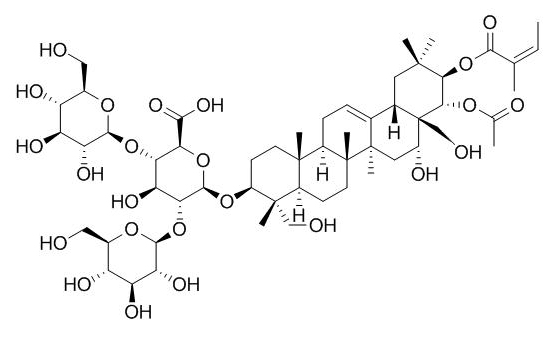Escin IB
Escin Ib inhibits gastric emptying, at least in part, mediated by capsaicin-sensitive sensory nerves, to stimulate the synthesis and/or release of dopamine, to act through central dopamine2 receptor, which in turn causes the release of PGs.
Inquire / Order:
manager@chemfaces.com
Technical Inquiries:
service@chemfaces.com
Tel:
+86-27-84237783
Fax:
+86-27-84254680
Address:
1 Building, No. 83, CheCheng Rd., Wuhan Economic and Technological Development Zone, Wuhan, Hubei 430056, PRC
Providing storage is as stated on the product vial and the vial is kept tightly sealed, the product can be stored for up to
24 months(2-8C).
Wherever possible, you should prepare and use solutions on the same day. However, if you need to make up stock solutions in advance, we recommend that you store the solution as aliquots in tightly sealed vials at -20C. Generally, these will be useable for up to two weeks. Before use, and prior to opening the vial we recommend that you allow your product to equilibrate to room temperature for at least 1 hour.
Need more advice on solubility, usage and handling? Please email to: service@chemfaces.com
The packaging of the product may have turned upside down during transportation, resulting in the natural compounds adhering to the neck or cap of the vial. take the vial out of its packaging and gently shake to let the compounds fall to the bottom of the vial. for liquid products, centrifuge at 200-500 RPM to gather the liquid at the bottom of the vial. try to avoid loss or contamination during handling.
Phytother Res.2023, 37(10):4587-4606.
JEJU National University2022, 10478.
J Nat Med.2020, 74(3):550-560.
Revista Brasileira de Farmacognosia2024, 34:1091-1100.
Journal of Ginseng Research2021, 3 June.
J Ethnopharmacol.2021, 267:113615.
Journal of Natural Remedies2024, 24(3):555ĘC575.
J of Advanced Scientific R.2020, 11(3), p109-120.
Phytomedicine.2019, 57:95-104
Sci Rep.2024, 14(1):23786.
Related and Featured Products
Life Sci. 2000;66(23):2233-8.
Possible involvement of 5-HT and 5-HT2 receptors in acceleration of gastrointestinal transit by escin Ib in mice.[Pubmed:
10855943]
METHODS AND RESULTS:
We have reported previously that Escin IB accelerated gastrointestinal transit (GIT) in mice, and that its effect may be mediated by the release of endogenous prostaglandins (PGs) and nitric oxide (NO). In this study, the possible involvement of 5-HT and 5-HT receptors in the GIT acceleration of Escin IB was investigated in mice. The acceleration of GIT by Escin IB (25 or 50 mg/kg, p.o.) was attenuated by pretreatment with ritanserin (0.5-5 mg/kg, s.c., a 5-HT(2A/2C/2B) receptor antagonist), but not with MDL 72222 (1 and 5 mg/kg, s.c.) and metoclopramide (10 mg/kg, s.c.) (5-HT3 receptor antagonists) or tropisetron (1 and 10 mg/kg, s.c., a 5-HT(3/4) receptor antagonist). Furthermore, pretreatment with ketanserin (0.05-5 mg/kg, s.c.), haloperidol (1-5 mg/kg, s.c.) and spiperone (0.5-5 mg/kg, s.c.) (5-HT2A receptor antagonists), as well as a bolus of dl-p-chlorophenylalanine methyl ester (PCPA, 1000 mg/kg, p.o., 1, 6 or 24 h before administration of the sample) (an inhibitor of 5-HT synthesizing enzyme tryptophan hydroxylase) and reserpine (5 mg/kg, p.o.) (a 5-HT depletor), but not 6-hydroxydopamine (80 mg/kg, i.p., a dopamine depletor) or repeated PCPA (300 mg/kg x2, p.o., 72 and 48 h before administration of the sample), also attenuated the effects of Escin IB.
CONCLUSIONS:
It is postulated that Escin IB accelerates GIT, at least in part, by stimulating the synthesis of 5-HT to act through 5-HT2, possibly 5-HT2A receptors, which in turn causes the release of NO and PGs.



